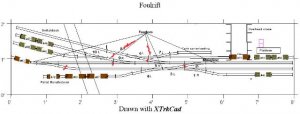I'm using Peco code100 insulfrog turnouts on my layout and have some questions-
1.According to what I have been told these are power routing but in a layout wiring book it says that turnouts with insulated frogs are all power.Which is correct?
2.In the literature that came with the turnout it states that they are ready to got right out of the box.All you have to do is feed power through the toe end which I'm assuming is the point side.Correct?
3.So based on this is it safe to assume that all I have to do is run some feeders connected to the point side and have it?
4.I even e-mailed Peco about this but they have yet to reply-How Rude!!
Thanks for any help-Bobwall1
1.According to what I have been told these are power routing but in a layout wiring book it says that turnouts with insulated frogs are all power.Which is correct?
2.In the literature that came with the turnout it states that they are ready to got right out of the box.All you have to do is feed power through the toe end which I'm assuming is the point side.Correct?
3.So based on this is it safe to assume that all I have to do is run some feeders connected to the point side and have it?
4.I even e-mailed Peco about this but they have yet to reply-How Rude!!
Thanks for any help-Bobwall1



